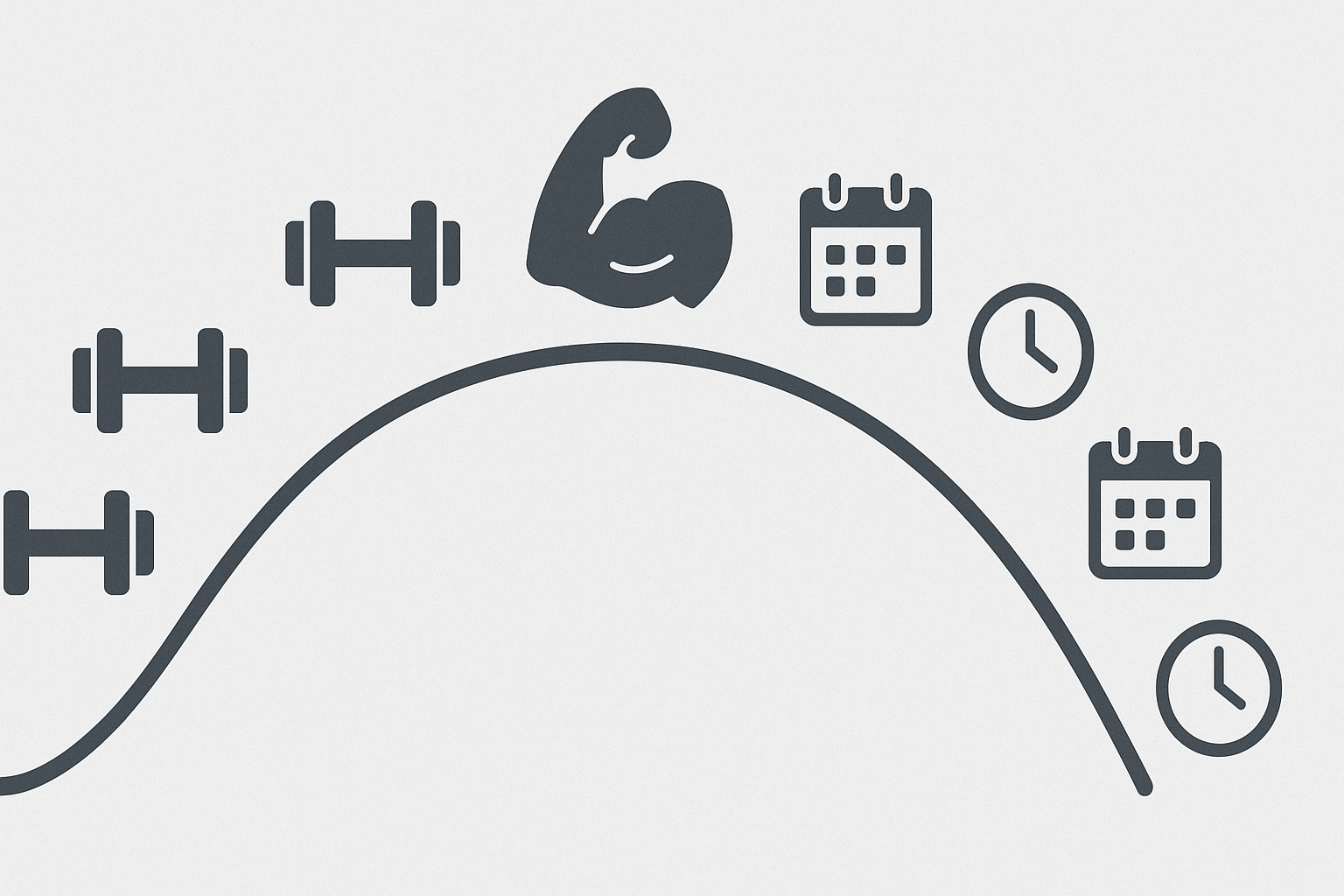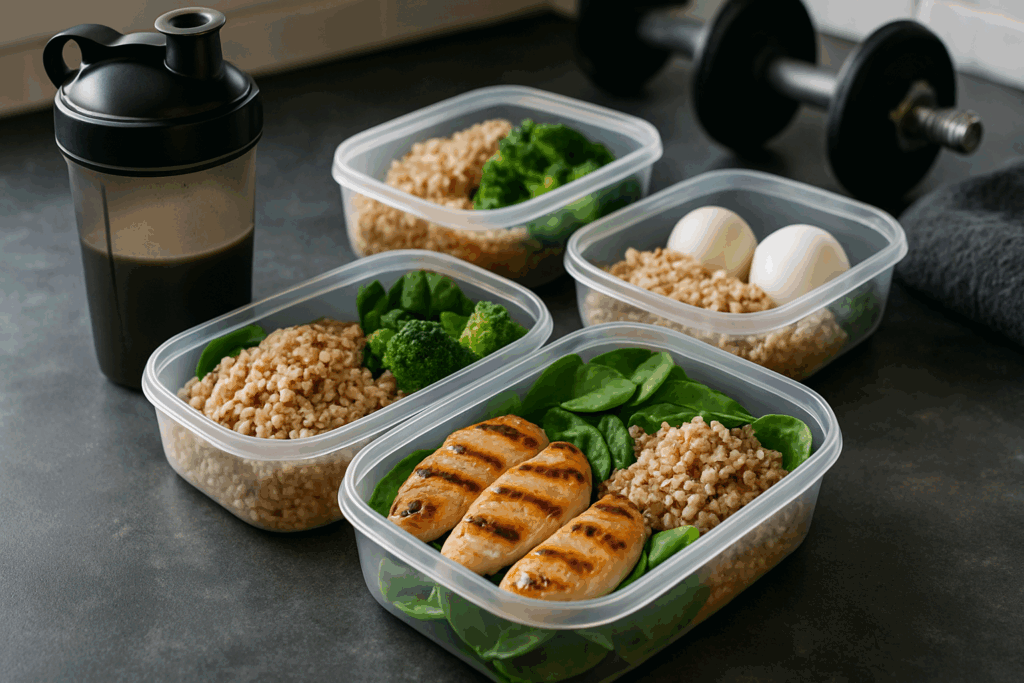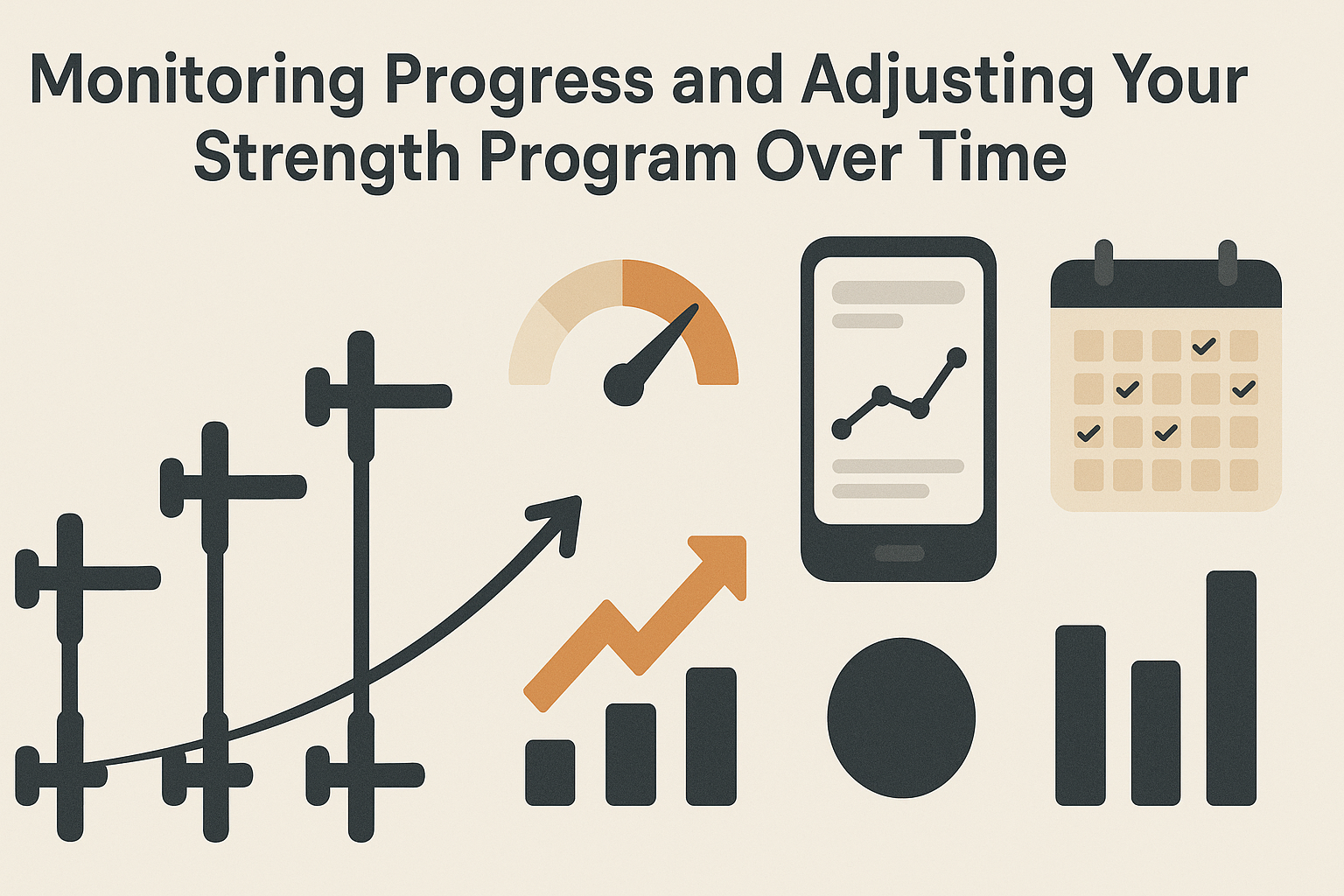Introduction: Why a Strength Program Matters for Serious Muscle Gains
Building muscle is both an art and a science. While the gym might seem like a playground for iron addicts, those who make the most progress aren’t guessing—they’re following a carefully crafted blueprint. At the core of lasting hypertrophy and strength development lies a proven strength program. This isn’t just about pumping iron until exhaustion, but about strategically using resistance training principles, recovery protocols, and nutrition to engineer a resilient, powerful physique. Whether you’re a beginner or a seasoned lifter, embracing a structured strength program can elevate your results far beyond what random workouts ever could.
You may also like: The Ultimate Hypertrophy Workout Program for Building Strength and Size

The Biological Foundation of Muscle Growth
Muscle development is driven by key physiological triggers: mechanical tension, muscle damage, and metabolic stress. These stimuli initiate a cascade of cellular events, including the activation of satellite cells and increased muscle protein synthesis. Hormones such as testosterone and IGF-1 play supporting roles in repairing and growing muscle tissue. The right strength building program taps into these mechanisms with intentional training volume, intensity, and frequency. Recovery is equally vital—muscle doesn’t grow in the gym but during rest, when the body rebuilds stronger in response to training stress.
Why Random Workouts Fail Without a Strength Training Program
One of the biggest obstacles to long-term muscle growth is inconsistency. Random workouts may keep things fresh, but they lack progressive overload and structure—two non-negotiables for sustainable progress. A proper strength training program brings coherence and direction to your training journey. It ensures you’re targeting the right muscle groups, managing fatigue, and gradually increasing the challenge to your body. Whether you’re aiming for aesthetics, power, or athletic performance, following a deliberate plan is essential. This is why many experts consider the best strength program one that evolves with your performance, rather than changing haphazardly.

Key Elements of a Proven Strength Program
A well-designed strength program includes phases, structure, and variation. Programs typically begin with a hypertrophy-focused phase to build muscle, followed by a strength-focused phase that increases the ability to lift heavier loads. These phases are periodized to prevent burnout and plateaus. Microcycles (weekly plans) and mesocycles (monthly blocks) create progressive adaptation. Periodization isn’t just a buzzword—it’s the strategic rotation of intensity and volume that allows your body to recover and grow. Additionally, deload weeks and planned rest are part of every serious strength lifting program, making recovery proactive instead of reactive.

Building on Compound Movements for Maximum Strength
The cornerstone of any best strength workout routine is the inclusion of compound lifts. These multi-joint exercises—squats, deadlifts, bench presses, and overhead presses—stimulate a vast array of muscle fibers and create systemic fatigue that promotes hormonal responses favorable to muscle growth. Unlike machines or isolation movements, compound lifts challenge your stability, coordination, and power. They also carry over into real-world tasks and athletic performance. Integrating these movements into a strength program helps lifters develop both functional and aesthetic muscle, particularly when paired with progressive overload and sound technique.
Accessory Exercises: The Glue That Holds Your Progress Together
Accessory work complements heavy compound lifts by addressing weak points, imbalances, and injury prevention. Movements like single-leg RDLs, face pulls, and weighted planks build stability and resilience in joints and smaller muscle groups. These exercises may not be flashy, but they contribute significantly to overall strength and symmetry. In a comprehensive strength gain workout program, accessory lifts ensure that no part of the kinetic chain is neglected. Over time, strengthening supporting muscles enhances your primary lifts, reduces injury risk, and leads to more consistent gains.
Customizing the Best Strength Workout Routine for Your Body and Goals
Not everyone thrives on the same training split. The best strength workout routine depends on your training age, recovery capacity, and individual biomechanics. Beginners may do well with full-body workouts three times a week, while intermediate lifters often benefit from upper/lower or push/pull splits. Advanced athletes might use more complex strategies like conjugate or block periodization. The important factor is individualization. Your strength program should align with your schedule, goals, and ability to recover. Rest days, exercise selection, and load management must all be tailored to you.

Eating for Gains: Nutrition in a Strength Training Program
Muscle building is as much about the kitchen as it is about the gym. A strength training program cannot succeed without proper nutritional support. Protein intake must be sufficient—generally between 1.6 and 2.2 grams per kilogram of body weight—to fuel muscle protein synthesis. Carbohydrates play a crucial role in replenishing glycogen stores and supporting training intensity, while healthy fats support hormone production. Nutrient timing—especially around workouts—can enhance performance and recovery. Supplementation with creatine, whey protein, and beta-alanine can also offer performance benefits when used alongside a solid strength lifting program.
Rest and Recovery: The Hidden Heroes of Muscle Growth
Training breaks the body down—recovery builds it back stronger. Without adequate sleep, rest, and active recovery, gains stall and injury risk skyrockets. Sleep is especially critical, as it’s when the body releases growth hormone and repairs tissue. Scheduled rest days, stretching, and light movement help promote circulation and reduce soreness. Programs that include deload weeks and respect the body’s need for rest outperform those that push through fatigue. Recovery isn’t laziness—it’s strategy. It’s what makes the difference between spinning your wheels and driving forward with real results.
Selecting the Best Strength Program for Your Training Experience
Your experience level should guide your program design. Beginners need simplicity, mastering the basics and focusing on steady, linear progression. For them, even a basic strength building program with consistent effort yields significant returns. Intermediate lifters need more volume and variation to continue progressing. Advanced trainees must carefully monitor fatigue and use complex periodization to eke out marginal gains. At every stage, choosing the right strength program means being honest about your current level and adapting when necessary. Programs that challenge without overwhelming tend to deliver the best long-term results.
Avoiding Pitfalls That Undermine Your Strength Program
Many lifters sabotage their progress by falling into common traps. Ego lifting, skipping warm-ups, neglecting sleep, or training through pain can derail even the best strength program. Failing to track progress makes it hard to identify plateaus or regressions. Another major issue is inconsistency—missing workouts or flipping between programs too frequently disrupts the flow of adaptation. Success comes from patient consistency, attention to form, and making incremental changes based on feedback from your body. Ultimately, a strength gain workout program works best when it’s viewed as a long-term investment, not a short-term hack.

Periodization: Structuring Long-Term Success in Your Strength Building Program
Periodization organizes your training to align with biological rhythms and recovery needs. Linear periodization, often used by beginners, steadily increases weight while reducing reps. Undulating periodization varies intensity and volume within a week, offering fresh stimulus while avoiding monotony. Block periodization, favored by advanced lifters, segments training into blocks focused on distinct adaptations like hypertrophy, strength, or peaking. Each method has merits, but all serve the same purpose: sustainable progression. A strength building program that applies periodization intelligently will outlast and outperform any routine that lacks structure or foresight.
Progressive Overload: The Essential Driver of Strength Gains
The law of progressive overload underpins every effective strength program. To grow, you must challenge your muscles more than they are accustomed to. This can be achieved by increasing weight, adding reps or sets, improving technique, or shortening rest intervals. It doesn’t require dramatic changes overnight; even adding five pounds to a lift every week compounds into significant progress over months. Tracking your lifts and adjusting based on performance ensures you’re always moving forward. The best strength program is not static—it evolves with you, adjusting the training load based on feedback, performance, and recovery.

Psychological Mastery: Mental Strategies for Long-Term Progress
Mental toughness, focus, and discipline are underrated aspects of strength training. Setting clear, measurable goals fuels motivation and provides direction. Visualization, affirmations, and consistent routines help condition your mind for performance. Strength training requires grit—the kind that shows up when motivation wanes. Overcoming mental fatigue, managing stress, and staying present in your training sessions all contribute to better lifts and more productive workouts. A successful strength gain workout program trains the mind as well as the body, turning adversity into fuel and setbacks into lessons.

Monitoring Progress and Adjusting Your Strength Program Over Time
Training progress is rarely linear. There will be plateaus, regressions, and breakthroughs. Tracking your volume, intensity, and performance trends enables intelligent adjustments. Tools like RPE (rate of perceived exertion), training journals, or apps provide valuable insights into how your body is responding. If progress stalls, it may be time to increase volume, modify exercise selection, or schedule a deload week. The best strength workout routine isn’t just about following a plan—it’s about understanding when and how to pivot. Being adaptable ensures that your program remains effective even as your body, lifestyle, and goals evolve.
Frequently Asked Questions (FAQ) on Building Muscle with a Strength Program
How do I know if my current strength program is actually working?
Determining the effectiveness of a strength program requires tracking more than just weight lifted. First, assess whether you’re consistently progressing in strength metrics, such as adding reps, sets, or increasing weight every few weeks. Equally important is evaluating how you feel physically—reduced joint pain, improved posture, and increased energy during workouts are strong indicators of success. Also, consider if the program is helping you maintain long-term motivation; a stale routine can stall results even if it’s technically sound. Lastly, take note of changes in muscle mass, body composition, and performance in related areas like mobility, endurance, or athletic tasks—these give a clearer picture than scale weight alone.
What makes a strength gain workout program more effective than a general fitness routine?
A strength gain workout program is built with specificity and periodization in mind, focusing on progressive overload, recovery, and phase transitions. Unlike general fitness routines that often prioritize calorie burn or variety, a dedicated strength training program targets the neuromuscular system with measurable load progression. Such programs emphasize heavier resistance, compound lifts, and structured rest periods, all of which maximize muscle recruitment and efficiency. Additionally, they incorporate deload phases and accessory lifts to support longevity and minimize injury. The best strength program includes a careful balance of intensity and recovery, creating a more sustainable path to hypertrophy and strength development.
Can I incorporate cardio without sabotaging my strength building program?
Yes, cardio can coexist with a strength building program if properly timed and dosed. Low to moderate-intensity steady-state cardio sessions, such as brisk walking or cycling, support cardiovascular health and recovery without overly taxing the nervous system. High-intensity interval training (HIIT) is best reserved for off-days or separated by several hours from resistance training. The key is to ensure that cardio volume doesn’t impede recovery or muscle protein synthesis. Many elite athletes use cardio strategically to enhance work capacity and improve nutrient partitioning, which ultimately supports rather than hinders a strength training program.
What is the difference between the best strength program and a powerlifting-specific plan?
While both approaches aim to build strength, the best strength program for general fitness or physique goals differs from a powerlifting-specific plan in several ways. Powerlifting plans prioritize the squat, bench press, and deadlift exclusively, with peaking phases aimed at one-rep max performance. A more versatile strength program, on the other hand, incorporates a broader range of movements to promote balanced development, mobility, and hypertrophy. It may include unilateral exercises, different rep ranges, and more variation across training blocks. Additionally, strength lifting programs for non-competitive lifters usually emphasize joint health, aesthetics, and long-term progression over immediate maximal output.
How can I avoid mental burnout while following a strength training program?
Burnout often stems from overreaching physically or losing motivation due to monotony. To prevent this, rotate training blocks every 4 to 6 weeks, integrating changes in rep ranges, exercise variations, or training splits. Taking planned deload weeks can significantly reduce fatigue accumulation. Psychological strategies also matter—set short-term goals, celebrate small wins, and use visualization techniques to stay mentally engaged. Social support plays a crucial role; training with a partner or sharing progress in a supportive community can reinvigorate your motivation and help you stay committed to your strength lifting program.
What are some overlooked recovery techniques that enhance strength training progress?
Beyond sleep and nutrition, recovery-enhancing techniques include contrast therapy (alternating hot and cold exposure), myofascial release using foam rollers or massage tools, and low-intensity aerobic sessions to increase blood flow. Breathwork practices, such as diaphragmatic breathing or box breathing, can improve autonomic recovery by enhancing parasympathetic nervous system activity. Additionally, tracking metrics like resting heart rate or heart rate variability provides insight into recovery status. Implementing even one or two of these methods can significantly amplify the effects of a strength gain workout program over time.
How should I adapt my strength program as I age?
As you age, preserving muscle mass and joint integrity becomes increasingly important. While the principles of progressive overload still apply, the rate of progression may slow, and recovery needs increase. Including more warm-up and mobility work helps maintain range of motion and prevent injuries. Emphasizing eccentric control and tempo training enhances neuromuscular coordination without placing undue stress on the joints. A well-designed strength training program for older adults also prioritizes frequency over intensity, spreading out the workload across the week. Most importantly, listening to biofeedback and adjusting load or volume accordingly will keep training effective and safe.
Integrating Mobility into Your Strength Program for Long-Term Performance
Many lifters neglect mobility until pain forces them to pay attention, but integrating it proactively into a strength program can yield tremendous benefits. Performing dynamic stretches before lifting improves movement quality and prevents joint compensation. Mobility drills tailored to specific lifts—like thoracic extensions for bench press or ankle mobility for squats—can enhance range of motion and reduce injury risk. Incorporating yoga or dedicated mobility sessions into rest days helps reset posture and improve tissue health. Ultimately, the best strength workout routine is one that keeps you moving well, not just lifting more.
How do I choose between different popular programs like 5/3/1, PHUL, or Starting Strength?
Each of these programs caters to a specific demographic and training goal. Starting Strength is ideal for novices looking to master foundational barbell movements and build a base. PHUL (Power Hypertrophy Upper Lower) is geared toward intermediates who want a hybrid approach that combines strength and size. Jim Wendler’s 5/3/1 emphasizes long-term progression and simplicity, making it a sustainable choice for busy lifters or those focusing on raw strength. The best strength program for you will depend on your goals, schedule, and experience. It’s worth experimenting with various formats before settling into one that aligns with your personal metrics and enjoyment.
Why do some people get better results from a strength building program even with less volume?
Training volume is only one piece of the puzzle. Factors like training intensity, exercise selection, movement efficiency, and recovery quality also determine adaptation. Some individuals are high responders and build strength with less volume due to superior neuromuscular efficiency or favorable genetics. Others benefit from using advanced techniques like cluster sets, rest-pause training, or accommodating resistance, which provide greater stimulus per set. Additionally, tightly managed lifestyle factors—sleep, stress, and nutrition—can amplify results from a lower-volume strength training program. It’s not about doing more but doing better with what you choose to focus on.
Conclusion: Unlock Lasting Muscle Growth with a Strategic Strength Program
A well-executed strength program is far more than just a workout schedule—it’s a comprehensive system that encompasses training, recovery, nutrition, mindset, and self-awareness. The most effective strength training program is one that aligns with your goals, adapts to your needs, and challenges you to improve consistently over time. From compound lifts to accessory movements, from progressive overload to periodization, each component works in harmony to drive sustainable growth and performance. Whether you’re a novice lifting your first barbell or an experienced athlete chasing new personal records, the path to strength is paved with structure, intention, and resilience. Embrace the journey, trust the process, and let a proven strength program be your guide to building the body and confidence you’ve always wanted.
Further Reading:
Guide to starting a strength training program





